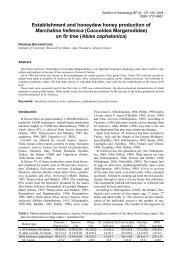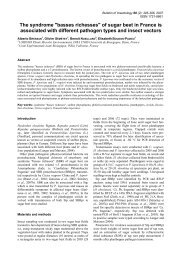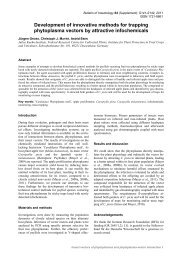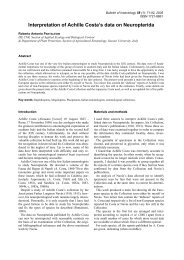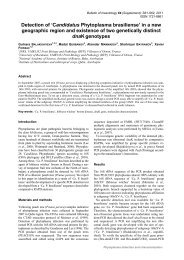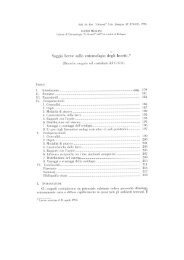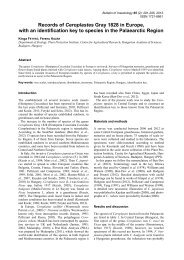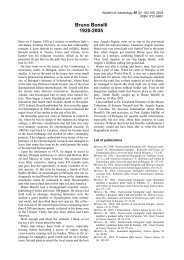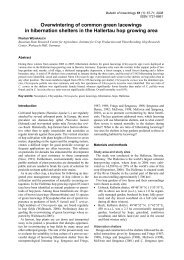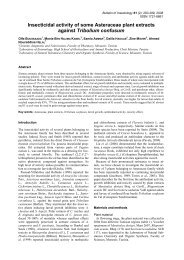The first report of a phytoplasma associated with pot marigold ...
The first report of a phytoplasma associated with pot marigold ...
The first report of a phytoplasma associated with pot marigold ...
You also want an ePaper? Increase the reach of your titles
YUMPU automatically turns print PDFs into web optimized ePapers that Google loves.
Bulletin <strong>of</strong> Insectology 64 (Supplement): S109-S110, 2011<br />
ISSN 1721-8861<br />
<strong>The</strong> <strong>first</strong> <strong>report</strong> <strong>of</strong> a <strong>phytoplasma</strong> <strong>associated</strong> <strong>with</strong><br />
<strong>pot</strong> <strong>marigold</strong> phyllody in Iran<br />
Seyyed Alireza ESMAILZADEH-HOSSEINI 1 , Mohammad SALEHI 2 , Amin KHANCHEZAR 2 , Mehdi SHAMSZADEH 1<br />
1<br />
Plant Protection Research Department, Agricultural and Natural Resources Research Center <strong>of</strong> Yazd, Yazd, Iran<br />
2<br />
Plant Protection Research Department, Agricultural and Natural Resources Research Center <strong>of</strong> Fars, Zarghan,<br />
Iran<br />
Abstract<br />
Pot <strong>marigold</strong> phyllody was observed in a Botanical Garden inYazd province <strong>of</strong> Iran. <strong>The</strong> disease agent was transmitted from <strong>pot</strong><br />
<strong>marigold</strong> to <strong>pot</strong> <strong>marigold</strong> and periwinkle via dodder inoculation. Polymerase chain reaction using <strong>phytoplasma</strong>-specific primer<br />
pair P1/P7 or nested PCR using primer pair P1/P7 followed by R16F2n/R16R2, amplified products <strong>of</strong> expected size (1.8 and 1.2<br />
kbp, respectively) from symptomatic <strong>pot</strong> <strong>marigold</strong> in the field and from symptomatic dodder inoculated <strong>pot</strong> <strong>marigold</strong> and periwinkle<br />
plants. Restriction fragment length polymorphism analysis <strong>of</strong> R16F2n/R16R2 primed nested PCR products indicated association<br />
<strong>of</strong> a peanut witches’ broom related <strong>phytoplasma</strong> (16SrII) in naturally and experimentally infected <strong>pot</strong> <strong>marigold</strong> plants. This<br />
is the <strong>first</strong> <strong>report</strong> <strong>of</strong> <strong>pot</strong> <strong>marigold</strong> phyllody in Iran.<br />
Key words: Pot <strong>marigold</strong> phyllody, 16SrII group, Yazd, Iran.<br />
Introduction<br />
Pot <strong>marigold</strong> (Calendula <strong>of</strong>ficinalis L. ) is a plant in the<br />
genus Calendula in the family Asteraceae native to<br />
southern Europe and cultivated in temperate regions<br />
around the world. It is a herbaceous ornamental plant<br />
<strong>with</strong> many medicinal, culinary and cosmetic uses.<br />
Phytoplasmas belonging to aster yellows (16SrI)<br />
group were identified in diseased <strong>pot</strong> <strong>marigold</strong> from Italy<br />
(Marcone et al., 1997 ) and Canada (Wang and Hiruki,<br />
2001). During a survey in 2006 in Yazd Botanical<br />
Garden, 30 km North west <strong>of</strong> Yazd (Yazd province,<br />
Iran), <strong>pot</strong> <strong>marigold</strong> phyllody (PMP) was observed (Esmailzadeh-Hosseini<br />
et al., 2008). In the present study<br />
the identification <strong>of</strong> <strong>phytoplasma</strong>s <strong>associated</strong> <strong>with</strong> PMP<br />
was carried out.<br />
Materials and methods<br />
A <strong>pot</strong> <strong>marigold</strong> plant <strong>with</strong> typical phyllody symptoms<br />
was selected in Yazd Botanical Garden, transferred to<br />
greenhouse and used as the source <strong>of</strong> the disease agent<br />
for dodder (Cuscuta campestris Yunck.) transmission<br />
and molecular studies. Infection <strong>of</strong> dodder-inoculated<br />
plants was verified by PCR. Total DNA was extracted<br />
from midrib tissue <strong>of</strong> 10 naturally phyllody affected <strong>pot</strong><br />
<strong>marigold</strong>, dodder inoculated and healthy plants using<br />
Zhang et al. (1998) procedure. DNA samples were tested<br />
for presence <strong>of</strong> <strong>phytoplasma</strong> by direct PCR using P1/P7<br />
(Schneider et al., 1995) and nested PCR using P1/P7 and<br />
R16F2n/R16R2 (Gundersen and Lee, 1996) primer pairs.<br />
For identification <strong>of</strong> <strong>phytoplasma</strong> <strong>associated</strong> <strong>with</strong> <strong>pot</strong><br />
<strong>marigold</strong> phyllody, R16F2n/R16R2 primed nested PCR<br />
products from naturally infected <strong>marigold</strong> and experimentally<br />
infected <strong>marigold</strong> and periwinkle plants were<br />
digested <strong>with</strong> AluI, HinfI, MseI, and RsaI restriction enzymes<br />
and digestion pr<strong>of</strong>iles were compared <strong>with</strong> those<br />
<strong>of</strong> known <strong>phytoplasma</strong>s. Furthermore, ELISA test using<br />
polyclonal antibody against Yazd alfalfa witches’ broom<br />
<strong>phytoplasma</strong>s (Esmailzadeh-Hosseini et al., 2003) was<br />
also used for identification <strong>of</strong> PMP agent.<br />
Results and iscussion<br />
Characteristic symptoms <strong>of</strong> the PMP disease were leaf<br />
size reduction, yellowing, phyllody, virescence, proliferation<br />
and sterility in the flower, proliferation <strong>of</strong> axillary<br />
buds along the stem, witches’ broom and stunting<br />
(figure 1).<br />
Up to 12% <strong>of</strong> the <strong>pot</strong> <strong>marigold</strong> plants were found infected<br />
in the field. Under greenhouse conditions, the<br />
agent <strong>of</strong> PMP was transmitted from naturally infected<br />
<strong>pot</strong> <strong>marigold</strong> to <strong>pot</strong> <strong>marigold</strong> and periwinkle via dodder<br />
inoculation.<br />
Figure 1. Pot <strong>marigold</strong> phyllody in Yazd Botanical<br />
Garden <strong>of</strong> Yazd province.<br />
(In colour at www.bulletin<strong>of</strong>insectology.org)<br />
New <strong>phytoplasma</strong> diseases
Figure 2. Virescence, phyllody and witches’ broom in a<br />
<strong>pot</strong> <strong>marigold</strong> plant dodder inoculated <strong>with</strong> PMP agent<br />
(left) compared <strong>with</strong> a healthy plant (right).<br />
(In colour at www.bulletin<strong>of</strong>insectology.org)<br />
Four <strong>of</strong> 5 <strong>pot</strong> <strong>marigold</strong> and all 5 periwinkle plants<br />
parasitized by dodder from infected <strong>pot</strong> <strong>marigold</strong> developed<br />
disease symptoms. <strong>The</strong> duration <strong>of</strong> the latent period<br />
in dodder-inoculated plants ranged from 6 to 11<br />
weeks. In dodder inoculated <strong>marigold</strong> (figure 2), disease<br />
symptoms were similar to those <strong>of</strong> naturally infected <strong>pot</strong><br />
<strong>marigold</strong> plants. <strong>The</strong> major symptoms shown by experimentally<br />
infected periwinkle plants were small<br />
leaves, virescence, phyllody, yellowing and stunting.<br />
DNA fragments <strong>of</strong> approximately 1,800 and 1,200 bp<br />
were amplified by direct and universal primer pairs<br />
P1/P7 and R16F2n/R16R2, respectively by direct and<br />
nested PCR from total nucleic acid samples extracted<br />
from 10 naturally phyllody-affected <strong>pot</strong> <strong>marigold</strong> and<br />
all symptomatic experimentally inoculated plants. No<br />
amplification was observed in DNA samples from<br />
symptomless plants and water control. R16F2n/R16R2<br />
primed nested PCR products (1.2 kbp) were analyzed by<br />
digestion <strong>with</strong> AluI, HinfI, MseI and RsaI enzymes. Collectively,<br />
RFLP patterns analyzed <strong>with</strong> these enzymes<br />
were similar to those <strong>of</strong> peanut witches’ broom, 16SrII<br />
group <strong>phytoplasma</strong>s (Lee et al., 1998). ELISA test using<br />
polyclonal antibody prepared against Yazd alfalfa<br />
witches’ broom (YAWB) <strong>phytoplasma</strong> showed that<br />
PMP <strong>phytoplasma</strong> is serologically related to YAWB<br />
agent, a 16SrII group related <strong>phytoplasma</strong>.<br />
On the basis <strong>of</strong> disease symptoms, dodder transmission<br />
and positive reaction in PCR and ELISA tests,<br />
PMP in Yazd has <strong>phytoplasma</strong>l etiology. This is the <strong>first</strong><br />
<strong>report</strong> <strong>of</strong> <strong>pot</strong> <strong>marigold</strong> phyllody disease in Iran. On the<br />
basis <strong>of</strong> RFLP analysis, this <strong>phytoplasma</strong> is related to<br />
S110<br />
‘Candidatus Phytoplasma aurantifolia’, 16SrII group<br />
<strong>phytoplasma</strong>. In other countries, an aster yellows–<br />
related <strong>phytoplasma</strong> (16SrI) was <strong>associated</strong> <strong>with</strong> the<br />
same disease (Marcone et al., 1997; Wang and Hiruki,<br />
2001) but no <strong>report</strong>s were found <strong>of</strong> <strong>pot</strong> <strong>marigold</strong> as a<br />
host for the 16SrII <strong>phytoplasma</strong> group. Alfalfa witches’<br />
broom is a peanut witches’ broom related <strong>phytoplasma</strong><br />
(16SrII) that is prevalent in Yazd province (Salehi et al.,<br />
1995). It is yet to be determined whether the agents <strong>of</strong><br />
YAWB and PMP are the same <strong>phytoplasma</strong>.<br />
References<br />
ESMAILZADEH-HOSSEINI S. A., SALEHI M., IZADPANAH K.,<br />
2003.- Production <strong>of</strong> polyclonal antiserum and serological<br />
identification <strong>of</strong> alfalfa witches’ broom in Yazd province.-<br />
Proceedings <strong>of</strong> the 3 rd Iranian Biotechnology Congress,<br />
Ferdowsi University <strong>of</strong> Mashad, Mashad, Iran: 122-124.<br />
ESMAILZADEH-HOSSEINI S. A., SALEHI M., FIROOZ R., SHAM-<br />
SZADEH M., 2008.- Occurrence <strong>of</strong> <strong>marigold</strong> phyllody in<br />
Yazd province.- 18 th Iranian Plant Protection Congress.<br />
Faculty <strong>of</strong> Agriculture, University <strong>of</strong> Bu-Ali Sina, Hamedan,<br />
Iran: 418.<br />
GUNDERSEN D. E., LEE I-M., 1996.- Ultrasensitive detection <strong>of</strong><br />
<strong>phytoplasma</strong>s by nested-PCR assays using two universal<br />
primer pairs.- Phytopathologia Mediterranea, 35: 144-151.<br />
LEE I-M., GUNDERSEN D. E., HAMMOND R. W., DAVIS R. E.,<br />
BARTOSZYK I. M., 1998.- Revised classification scheme for<br />
<strong>phytoplasma</strong> based on RFLP analysis <strong>of</strong> 16S rRNA and ribosomal<br />
protein gene sequences.- International Journal <strong>of</strong><br />
Systematic Bacteriology, 48: 1153-1169.<br />
MARCONE C., RAGOZZINO A., SEEMULLER E., 1997.- Detection<br />
and identification <strong>of</strong> <strong>phytoplasma</strong>s in yellows-disesased<br />
weeds in Italy.- Plant Pathology, 46: 530-537.<br />
SALEHI M., IZADPANAH K., EBRAHIMNESBAT F., 1995.- Etiology,<br />
transmission and host range <strong>of</strong> alfalfa witches’ broom<br />
in Iran.- Iranian Journal <strong>of</strong> Plant Pathology, 31(1-4): 1-9.<br />
SCHNEIDER B., SEEMÜLLER E., SMART C. D., KIRKPATRICK B.<br />
C., 1995.- Phylogenetic classification <strong>of</strong> plant pathogenic<br />
mycoplasma-like organisms or <strong>phytoplasma</strong>s, pp. 369-380.<br />
In: Molecular and Diagnostic Procedures in Mycoplasmology,<br />
Vol. I (RAZIN S., TULLY, J. G., Eds).- Academic Press,<br />
San Diego, CA, USA.<br />
WANG K., HIRUKI C., 2001.- Use <strong>of</strong> heteroduplex mobility assay<br />
for identification and differentiation <strong>of</strong> <strong>phytoplasma</strong>s in<br />
the aster yellows group and the clover proliferation group.-<br />
Phytopathology, 91: 546-552.<br />
ZHANG Y. P., UYEMOTO J. K., KIRKPATRICK B. C., 1998.- A<br />
small-scale procedure for extracting nucleic acids from<br />
woody plants infected <strong>with</strong> various phytopathogens for PCR<br />
assay.- Journal <strong>of</strong> Virological Methods, 71: 45-50.<br />
Corresponding author: Seyyed A. ESMAILZADEH-<br />
HOSSEINI (e-mail: saesmailzadeh@yahoo.com), Plant<br />
Protection Research Department, Agricultural and Natural<br />
Resources Research Center <strong>of</strong> Yazd, Yazd, Iran.



